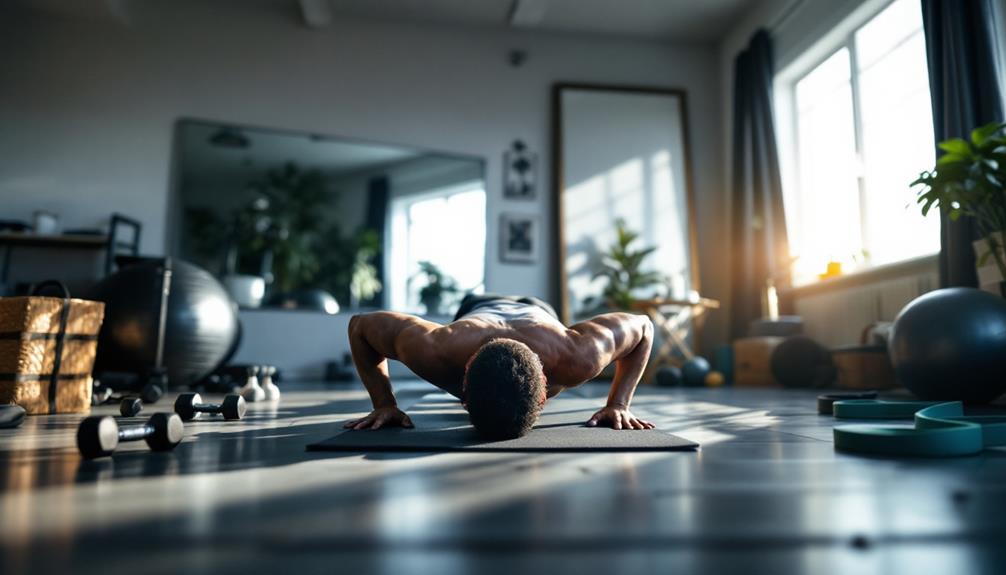Mastering upper body resistance training at home is a great way to enhance your fitness and build muscle tone. Start with essential equipment, like adjustable dumbbells and resistance bands. Focus on major muscle groups—chest, back, shoulders, and arms—using exercises like push-ups, bent-over rows, and lateral raises. Aim for 2-3 workouts per week, lasting 30-60 minutes, with 3-4 sets of 8-12 repetitions. Incorporate a mix of pushing, pulling, and core exercises for balanced strength. Remember to track your progress to stay motivated. If you're looking to optimize your routine, there's more to uncover on this topic.
Core Insight
- Focus on major muscle groups by incorporating push-ups, rows, and shoulder presses for balanced upper body strength.
- Utilize essential equipment like adjustable dumbbells and resistance bands to enhance workout variety and effectiveness.
- Structure workouts with 2-3 sessions per week, lasting 30-60 minutes, including pushing, pulling, and core exercises.
- Aim for 3-4 sets of 8-12 repetitions per exercise, adjusting resistance for toning or building strength.
- Incorporate rest periods of 30-90 seconds between sets to optimize recovery and performance during workouts.
Benefits of Upper Body Training

Adding upper body resistance training to your routine helps you get stronger and boosts your overall fitness. This type of training improves muscle tone, giving you a more defined look. Stronger upper body muscles make everyday tasks, like lifting or reaching, much easier.
Using resistance tubes is a great option for upper body workouts. They are portable and come with resistance levels ranging from 2 lbs to over 40 lbs, so you can find the right fit for your fitness goals.
Upper body exercises can also increase your metabolism, which helps with weight management. They support better posture, reducing the chance of back pain from sitting too long. Plus, you'll notice better stability and coordination, which can enhance your performance in other activities.
In short, incorporating upper body resistance training into your fitness routine helps you feel strong and capable in all areas of life.
Essential Equipment for Home Workouts

To effectively do upper body workouts at home, having the right equipment is important. Start with a set of adjustable dumbbells. They are versatile and can be used for many different exercises. Adjustable dumbbells save space in your home gym and let you easily change weights for various workouts.
Resistance bands are another great option. They are light and perfect for adding resistance without taking up much room. A stability ball can also improve your workout by engaging your core while you train your upper body. Lastly, think about getting a pull-up bar. It is excellent for building strength in your back and arms.
With this essential equipment, you'll be ready for your upper body workouts. Remember, staying consistent is key, so invest in quality gear that fits your training style and keeps you motivated.
Targeting Major Muscle Groups
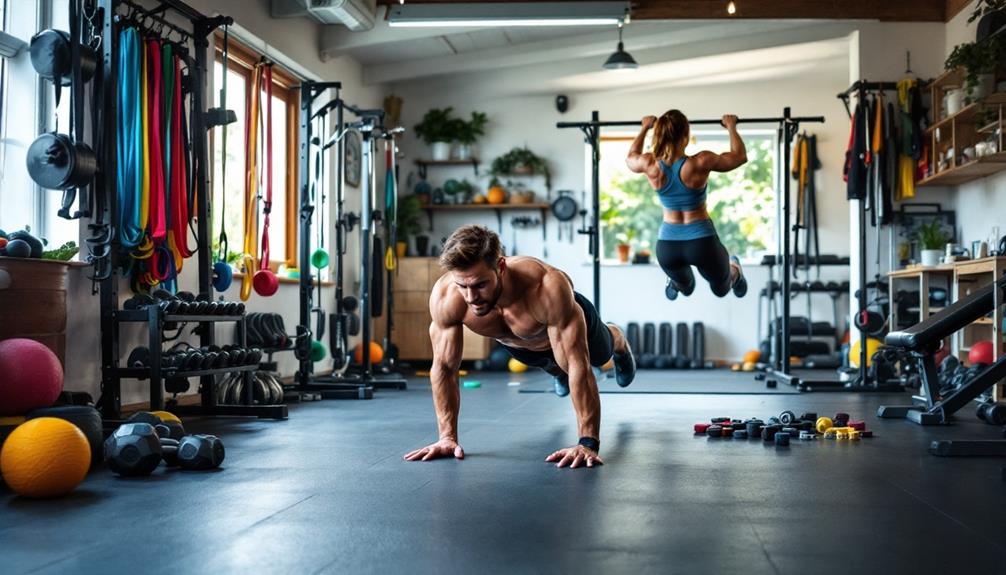
How can you effectively target major muscle groups in your upper body workouts at home? Start by focusing on the key areas: your chest, back, shoulders, and arms. Use exercises that work these muscle groups to build balanced strength.
For your chest, you can do push-ups or chest presses. To target your back, try rows or pull-ups. Don't forget about your shoulders; shoulder presses and lateral raises are great options. For your arms, include bicep curls and tricep dips.
Remember to engage your core during these exercises to help with stability. Aim for a mix of movements to ensure all muscle groups are activated. Changing up your routine keeps things fresh and helps you build strength more effectively.
Using a TRX system can also help. It offers flexible anchoring options for different upper body exercises, making it a good choice for home workouts because it is portable and doesn't take up much space.
Sample Resistance Training Exercises
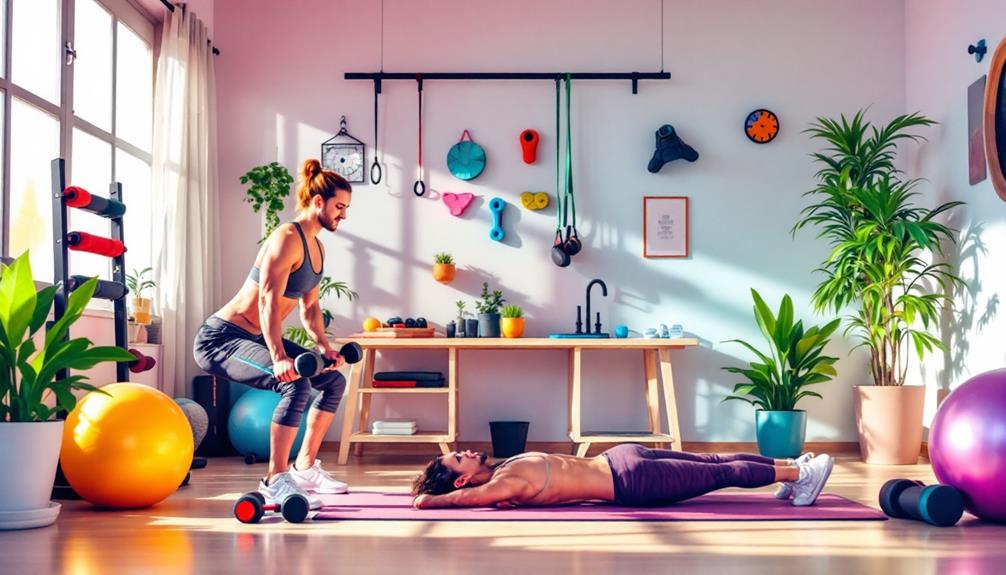
Adding resistance training exercises to your routine can really improve your upper body strength. Start with push-ups to work on your chest, shoulders, and triceps. If regular push-ups are too challenging, you can try knee push-ups or incline push-ups.
Next, do bent-over rows with dumbbells or a resistance band to strengthen your back and biceps. For your shoulders, try lateral raises using light weights. Resistance tubes come in different levels, from 2 lbs to over 40 lbs, so you can adjust the intensity of your workout. Use lighter resistance for toning and heavier resistance for building strength.
Don't forget about tricep dips. You can do these using a sturdy chair or bench. Aim for 8-12 repetitions of each exercise, and feel free to change the weights as you get stronger. Always focus on keeping good form to get the most out of your workout and avoid injuries. By regularly doing these exercises, you will build a strong upper body right at home.
Structuring Your Workout Routine
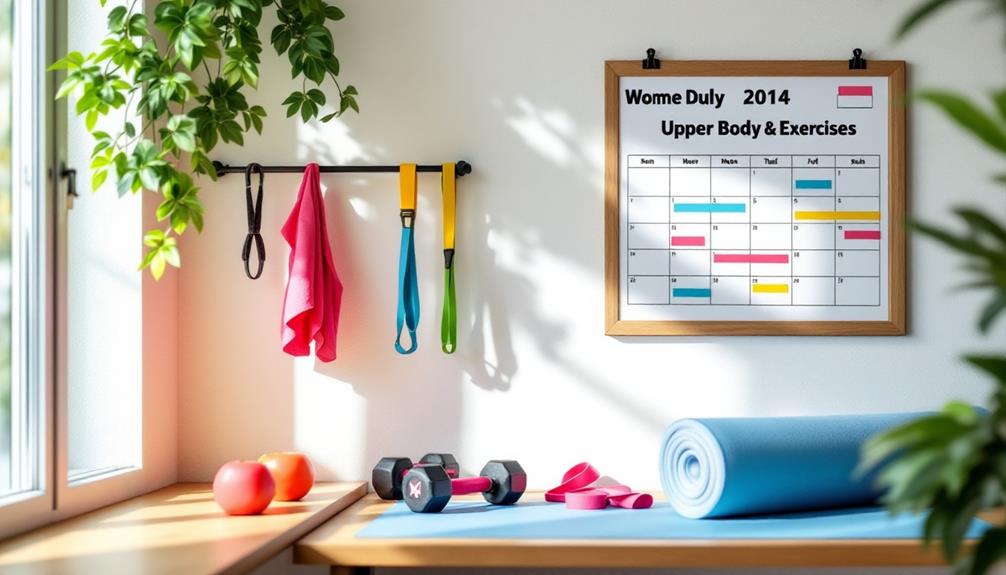
Creating a good workout routine for upper body resistance training at home is important. Start by setting your goals and looking at the equipment you have. Resistance tubes are a great choice because they are flexible and easy to use. They come in different resistance levels, from 2 lbs to over 40 lbs. Here's a simple plan to help you get started:
- Frequency: Aim for 2 to 3 workouts each week.
- Duration: Keep each workout between 30 and 60 minutes.
- Exercise Selection: Include a mix of pushing, pulling, and core exercises.
- Sets and Reps: Do 3 to 4 sets of 8 to 12 repetitions for strength.
- Rest Periods: Take 30 to 90 seconds of rest between sets.
Tips for Effective Training
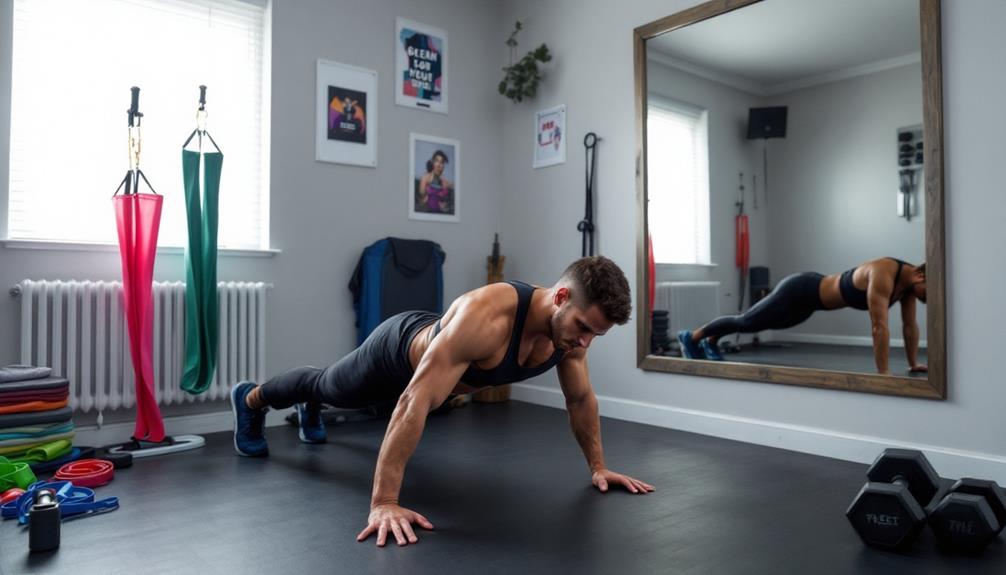
To get the most out of your upper body resistance training at home, pay attention to your form and technique. Move slowly and carefully to engage the right muscles and avoid injury. Find a quiet space to work out, free from distractions.
When choosing resistance tubes, look for color-coded options. These help you easily identify resistance levels, which can range from 2 lbs to over 40 lbs. This makes it easier to increase your strength over time.
Include a mix of exercises to work different muscle groups, such as push-ups, rows, and shoulder presses. Always warm up before your workout to prepare your muscles, and cool down afterward to help with recovery.
Tracking Your Progress
- Keep a workout journal: Write down your exercises, sets, and reps. Using resistance bands is a great way to track your progress since you can easily note which band resistance you're using for each exercise.
- Use an app: There are many fitness apps available that can help you log your workouts and see your progress.
- Take progress photos: Take pictures of your body every few weeks to notice any changes.
- Measure strength gains: Keep a record of the weights you lift to see how you improve.
- Set specific goals: Make short-term and long-term goals to help keep you accountable.
Frequently Asked Questions
Can I Build Muscle Without Going to a Gym?
Yes, you can build muscle without going to a gym. By using bodyweight exercises, resistance bands, or free weights at home, you'll effectively engage your muscles and promote growth, all while saving time and money.
How Often Should I Train My Upper Body?
You should train your upper body about two to three times a week. This frequency allows for muscle recovery while promoting growth. Just remember to vary your exercises to keep challenging your muscles effectively.
Is It Safe to Train With Injuries?
Imagine a tree bending in the wind—it's wise to listen to your body. If you're injured, training can worsen the problem. Consult a professional before resuming to guarantee you're nurturing your strength safely.
What Are Common Mistakes in Upper Body Training?
Common mistakes in upper body training include poor form, neglecting warm-ups, overtraining, and skipping balanced exercises. You should focus on proper technique, incorporate rest, and make sure you're working all muscle groups for best results.
How Do I Stay Motivated for Home Workouts?
Think of Odysseus, journeying home. Stay motivated by setting clear goals, creating a routine, and tracking progress. Reward yourself for milestones, and remember, consistency breeds success. You've got this—keep pushing through!

